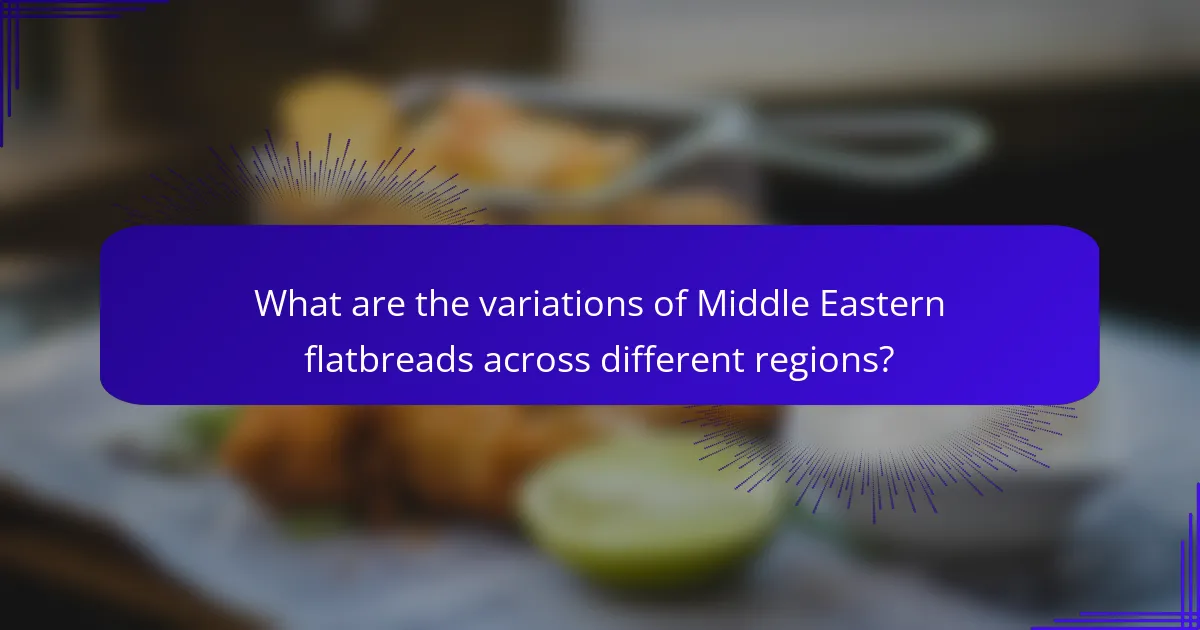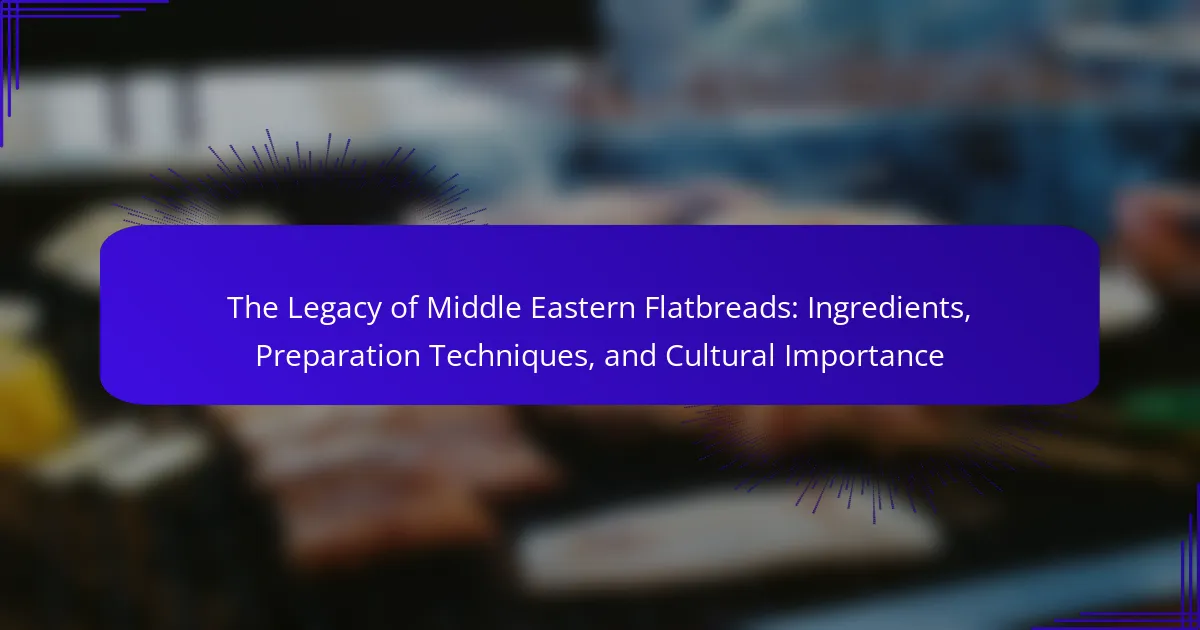
What are Middle Eastern Flatbreads?
Middle Eastern flatbreads are unleavened or leavened breads traditionally consumed in the Middle East. They include varieties such as pita, lavash, and khubz. These breads are typically made from flour, water, and salt. The dough is either rolled out or baked in a hot oven. Pita bread is known for its pocket-like structure, which forms during baking. Lavash is a thin, soft flatbread often used for wraps. Khubz is a staple in many Middle Eastern meals, serving as a side or utensil. The preparation techniques vary by region and cultural practices. Flatbreads have been a dietary staple in the Middle East for centuries, reflecting the region’s agricultural history.
How are Middle Eastern flatbreads categorized?
Middle Eastern flatbreads are categorized primarily into two types: leavened and unleavened. Leavened flatbreads, such as pita and lavash, contain yeast or other leavening agents, causing them to rise during baking. Unleavened flatbreads, like matzah and tortillas, do not use leavening, resulting in a denser texture.
These categories are also influenced by regional variations. For example, the Levant region is known for pita, while the Arabian Peninsula features khubz. Each type has unique preparation techniques and cultural significance. The categorization reflects both the ingredients used and the traditional methods of making these breads, showcasing the diversity within Middle Eastern cuisine.
What are the most common types of Middle Eastern flatbreads?
The most common types of Middle Eastern flatbreads are pita, lavash, and manakish. Pita is a round, pocket-style bread that puffs up during baking. It is often used to scoop up dips or as a wrap. Lavash is a thin, unleavened bread that can be soft or crispy. It is typically used for wraps or as a side with meals. Manakish is a flatbread topped with za’atar or cheese, often enjoyed for breakfast. These breads are staples in Middle Eastern cuisine and have been consumed for centuries. Their preparation methods vary by region, reflecting local traditions and ingredients.
What distinguishes each type of flatbread?
Each type of flatbread is distinguished by its ingredients, preparation methods, and cultural significance. For example, pita bread is made with wheat flour and is characterized by its pocket, formed during baking. Lavash, another type, is thinner and often made with whole wheat flour, resulting in a chewy texture. Naan is typically leavened, giving it a soft and pillowy quality, and is often cooked in a tandoor. Injera, an Ethiopian flatbread, is unique due to its fermentation process, which gives it a sour flavor and spongy texture. Each flatbread type reflects regional ingredients and cooking traditions, showcasing the diversity of Middle Eastern culinary practices.
What are the key ingredients used in Middle Eastern flatbreads?
The key ingredients used in Middle Eastern flatbreads are flour, water, salt, and yeast. These ingredients form the base of the dough. Commonly used flours include all-purpose flour and whole wheat flour. Water hydrates the flour, allowing gluten to develop. Salt adds flavor and strengthens the dough structure. Yeast acts as a leavening agent, creating a light texture. Some variations may include additional ingredients like yogurt or olive oil for enhanced flavor and moisture. These fundamental ingredients contribute to the unique textures and tastes of different flatbreads across the region.
How do different flours affect the texture and flavor?
Different flours significantly influence the texture and flavor of flatbreads. Wheat flour generally yields a chewy texture and mild flavor. This is due to its gluten content, which provides elasticity. In contrast, whole wheat flour creates a denser texture and nuttier flavor. This results from the bran and germ present in the flour.
Rice flour produces a lighter texture and a slightly sweet flavor. This is often used in gluten-free flatbreads. Corn flour contributes a unique sweetness and a crumbly texture. This is common in traditional Middle Eastern breads like cornbread.
Barley flour offers a slightly bitter flavor and a dense texture, enhancing the bread’s nutritional profile. Spelt flour, an ancient grain, provides a nutty flavor and a chewy texture. Each flour type contributes to the overall sensory experience of the bread.
What role do leavening agents play in flatbread preparation?
Leavening agents are crucial in flatbread preparation as they create gas bubbles that help the dough rise. This process results in a lighter and airier texture. Common leavening agents for flatbreads include yeast and baking powder. Yeast ferments sugars in the dough, producing carbon dioxide. This gas expands during baking, causing the dough to rise. Baking powder releases carbon dioxide when mixed with moisture and heat. The use of leavening agents distinguishes leavened flatbreads from unleavened varieties. Historical practices show that many cultures have utilized leavening agents for centuries. This technique enhances the overall quality and palatability of the flatbread.
Why are Middle Eastern flatbreads culturally significant?
Middle Eastern flatbreads are culturally significant because they represent a staple food in the region’s diet. These breads, such as pita and lavash, have been consumed for thousands of years. They are often used in communal meals, enhancing social bonds among families and communities. The preparation of flatbreads involves traditional techniques passed down through generations. This practice reflects the cultural heritage and identity of various Middle Eastern societies. Additionally, flatbreads serve as a vehicle for other foods, symbolizing hospitality and sharing. Their presence in religious and festive occasions underscores their importance in cultural rituals. Overall, Middle Eastern flatbreads embody the region’s historical and social narratives.
How do flatbreads reflect the history of the Middle East?
Flatbreads reflect the history of the Middle East through their ancient origins and cultural significance. They have been a staple food for thousands of years. Archaeological evidence shows flatbreads dating back to 14,000 years ago in the region. The ingredients used, such as wheat and barley, highlight agricultural practices of early civilizations. Preparation techniques, like baking on hot stones, demonstrate resourcefulness and adaptation to local environments. Flatbreads are also integral to communal meals, symbolizing hospitality and shared culture. Their variations across different cultures illustrate the influence of trade and migration in the region’s history. Overall, flatbreads serve as a culinary link to the Middle East’s diverse and rich heritage.
What rituals or traditions involve flatbreads in Middle Eastern cultures?
Flatbreads are integral to various rituals and traditions in Middle Eastern cultures. They often symbolize hospitality and community during gatherings. For instance, during Ramadan, families break their fast with flatbreads alongside other dishes. In weddings, flatbreads are served to guests as a sign of abundance and celebration. Additionally, flatbreads are used in religious ceremonies, such as during the Jewish Passover, where matzah, a type of flatbread, is consumed. These practices highlight the cultural significance of flatbreads in fostering social connections and honoring traditions.

What preparation techniques are used for Middle Eastern flatbreads?
Middle Eastern flatbreads are typically prepared using techniques such as mixing, kneading, resting, and baking. The dough is often made from simple ingredients like flour, water, and salt. After mixing, the dough is kneaded to develop gluten, which gives the bread its structure.
Resting the dough is crucial; it allows the gluten to relax, making it easier to shape. The dough is then divided into small portions and rolled out into thin rounds. Baking can occur in various ways, including using a traditional clay oven called a taboon or on a hot griddle.
Each technique contributes to the bread’s texture and flavor. For example, baking at high temperatures creates a characteristic puff and chewiness. Historical practices show that these methods have been passed down through generations, highlighting their cultural significance in Middle Eastern cuisine.
How is the dough for flatbreads typically prepared?
The dough for flatbreads is typically prepared using flour, water, and salt. The flour is often a combination of wheat flour or whole wheat flour. Water is added gradually to form a cohesive dough. Salt is mixed in for flavor enhancement. The dough is kneaded until smooth and elastic, which usually takes about 5 to 10 minutes. After kneading, the dough is allowed to rest for a period, usually 30 minutes to an hour. This resting period helps to relax the gluten, making the dough easier to roll out. The preparation method can vary slightly depending on regional traditions, but these fundamental steps remain consistent across many cultures.
What methods are used to knead and rest the dough?
Kneading dough involves several methods, including hand kneading and machine kneading. Hand kneading requires pressing, folding, and stretching the dough to develop gluten. This method typically takes about 10 to 15 minutes. Machine kneading uses a stand mixer with a dough hook for convenience. This method usually takes 5 to 7 minutes.
Resting the dough is also essential. After kneading, dough should rest to allow gluten to relax. This resting period can range from 30 minutes to several hours, depending on the recipe. During this time, the dough can rise and develop flavor.
Both kneading and resting are crucial for achieving the desired texture in flatbreads. Proper techniques help create a light and airy final product.
How does hydration level impact the dough consistency?
Hydration level directly influences dough consistency. Higher hydration levels result in a wetter, stickier dough. This allows for better gluten development, leading to a more elastic texture. Conversely, lower hydration yields a drier, firmer dough. This can make the dough easier to handle but may result in a denser final product. Research indicates that dough with 60-70% hydration is often optimal for many bread types, promoting a balance between extensibility and elasticity. Consistency also affects the final bread’s crumb structure and mouthfeel.
What cooking methods are employed for flatbreads?
Flatbreads are typically cooked using methods such as baking, grilling, and frying. Baking involves placing the dough in an oven, often on a hot surface like a stone or metal sheet. This method allows for even cooking and a crispy texture. Grilling involves cooking the flatbread over an open flame or on a grill, imparting a smoky flavor. Frying is done in a pan with oil, resulting in a softer, more pliable texture. Each method contributes distinct characteristics to the flatbread, enhancing its versatility in various culinary applications.
How do traditional cooking methods differ from modern techniques?
Traditional cooking methods often emphasize slow, labor-intensive processes, while modern techniques prioritize efficiency and convenience. Traditional methods, such as stone baking and open-fire cooking, rely on natural heat sources. These methods often enhance flavor and texture in foods like Middle Eastern flatbreads.
Modern techniques, on the other hand, utilize electric ovens and advanced kitchen appliances. These innovations allow for quicker cooking times and consistent results. For example, electric ovens provide precise temperature control, which is less common in traditional methods.
Additionally, traditional cooking often involves communal practices, reflecting cultural significance. In contrast, modern cooking can be more individualistic and fast-paced. This shift impacts not only the preparation of food but also the cultural rituals surrounding meals.
What equipment is essential for cooking flatbreads effectively?
A rolling pin is essential for cooking flatbreads effectively. It helps in flattening the dough evenly. A flat surface, like a countertop or a cutting board, provides a stable area for rolling. A cast iron skillet or a tawa is ideal for cooking flatbreads. These materials distribute heat evenly, ensuring proper cooking. A spatula is useful for flipping the flatbreads without damaging them. A thermometer can help monitor the cooking temperature for optimal results. These tools are commonly used in traditional flatbread preparation. Each piece of equipment contributes to achieving the desired texture and flavor.

What are the variations of Middle Eastern flatbreads across different regions?
Variations of Middle Eastern flatbreads include pita, lavash, and khubz. Pita is a round, pocket-style bread common in Levantine cuisine. Lavash is a thin, unleavened bread prevalent in Armenia and Iran. Khubz, often referred to as Arabic bread, is popular in the Arabian Peninsula. Each bread has unique preparation methods. For instance, pita is baked at high temperatures to create its pocket. Lavash is traditionally cooked on hot stones or in tandoors. Khubz is typically made with whole wheat flour and can be baked or cooked on a griddle. These variations reflect regional ingredients and cooking techniques. The diversity of flatbreads showcases the rich culinary heritage of the Middle East.
How do regional ingredients alter flatbread recipes?
Regional ingredients significantly alter flatbread recipes by influencing flavor, texture, and nutritional content. Different regions use locally available grains, such as wheat, barley, or millet, which affect the flatbread’s characteristics. For instance, Middle Eastern flatbreads often utilize wheat flour, resulting in a soft and pliable texture. In contrast, Indian flatbreads frequently incorporate whole wheat or chickpea flour, yielding a denser and nuttier flavor.
Additionally, the inclusion of regional spices and herbs enhances the taste profile. For example, za’atar, commonly found in Middle Eastern regions, adds a unique aromatic quality to the bread. Variations in water quality and mineral content can also impact dough consistency and fermentation processes.
Cultural practices dictate preparation techniques, such as cooking methods and fermentation times, which further differentiate flatbreads. Tandoori ovens in South Asia create a distinct charred flavor, while stone ovens in Mediterranean regions provide a crispy crust. These elements illustrate how regional ingredients and practices shape the diverse array of flatbread recipes across cultures.
What are some unique flatbreads from specific Middle Eastern countries?
Lahmacun from Turkey is a unique flatbread topped with minced meat and spices. It serves as a popular street food. Manakish from Lebanon features a dough topped with za’atar or cheese. It is often enjoyed for breakfast. Khubz from the Gulf countries is a round, soft flatbread used to scoop up various dishes. It is a staple in many households. Barbari from Iran is a thick, elongated flatbread with a crunchy crust. It is traditionally baked in a tandoor oven. Each of these flatbreads reflects the culinary traditions of their respective countries.
What contemporary trends are influencing Middle Eastern flatbreads?
Contemporary trends influencing Middle Eastern flatbreads include the rise of health-conscious ingredients and artisanal baking techniques. Many consumers are seeking whole grain and gluten-free options. This shift is driven by increasing awareness of health and dietary preferences. Additionally, traditional baking methods are being revived, emphasizing authenticity and craftsmanship. The popularity of flatbreads in global cuisine is also expanding, leading to fusion recipes. Food trucks and casual dining establishments are incorporating flatbreads into diverse menus. Social media plays a role in showcasing innovative flatbread recipes and techniques. These trends reflect a blend of tradition and modern culinary practices.
How are chefs innovating traditional flatbread recipes?
Chefs are innovating traditional flatbread recipes by incorporating diverse ingredients and modern cooking techniques. They experiment with alternative flours, such as chickpea or almond flour, to cater to dietary preferences. Some chefs are adding unique flavors through herbs and spices, enhancing the traditional taste. Others are utilizing advanced cooking methods, like sous-vide or fermentation, to improve texture and flavor depth.
For example, using activated charcoal in dough creates visually striking flatbreads. Chefs also focus on health by reducing gluten content or adding superfoods. The rise of plant-based diets has led to flatbreads featuring ingredients like spinach or beetroot. This innovation reflects a blend of cultural heritage with contemporary culinary trends, making flatbreads more versatile and appealing.
What fusion cuisines are emerging that feature Middle Eastern flatbreads?
Emerging fusion cuisines featuring Middle Eastern flatbreads include Mediterranean-Mexican and Asian-Middle Eastern hybrids. Mediterranean-Mexican cuisine combines elements like za’atar flatbreads with taco fillings. Asian-Middle Eastern fusion often incorporates flatbreads in dishes like shawarma bao. These innovations reflect a growing trend of blending diverse culinary traditions. The popularity of these fusions is evident in urban food markets and restaurants. Chefs experiment with flavors and textures, creating unique dining experiences. As a result, Middle Eastern flatbreads gain new cultural significance. This evolution showcases the adaptability of traditional foods in modern gastronomy.
What tips can enhance the experience of making and enjoying Middle Eastern flatbreads?
To enhance the experience of making and enjoying Middle Eastern flatbreads, focus on using high-quality ingredients. Fresh flour contributes to better texture and flavor. Incorporate yogurt or milk for added richness in the dough. Allow the dough to rest for at least 30 minutes to improve elasticity. Use a hot cooking surface, such as a cast-iron skillet or a tandoor, for optimal cooking. Flip the flatbread when bubbles form for even cooking. Serve with traditional dips like hummus or baba ghanoush to complement the flavors. Enjoying flatbreads warm enhances their taste and texture.
Middle Eastern flatbreads, including varieties such as pita, lavash, and khubz, are fundamental components of the region’s cuisine, made primarily from flour, water, and salt. This article explores the categorization of flatbreads into leavened and unleavened types, their key ingredients, and the preparation techniques that define them. It also delves into the cultural significance of flatbreads, their historical roots, and the rituals that incorporate them in Middle Eastern societies. Additionally, contemporary trends and innovations in flatbread recipes are examined, highlighting their evolving role in both traditional and modern culinary contexts.
